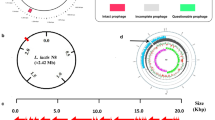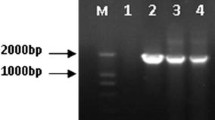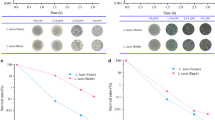Abstract
Acid accumulation caused by carbon metabolism severely affects the fermentation performance of microbial cells. Here, different sources of the recT gene involved in homologous recombination were functionally overexpressed in Lactococcus lactis NZ9000 and Escherichia coli BL21, and their acid-stress tolerances were investigated. Our results showed that L. lactis NZ9000 (ERecT and LRecT) strains showed 1.4- and 10.4-fold higher survival rates against lactic acid (pH 4.0), respectively, and that E. coli BL21 (ERecT) showed 16.7- and 9.4-fold higher survival rates than the control strain against lactic acid (pH 3.8) for 40 and 60 min, respectively. Additionally, we found that recT overexpression in L. lactis NZ9000 improved their growth under acid-stress conditions, as well as increased salt- and ethanol-stress tolerance and intracellular ATP concentrations in L. lactis NZ9000. These findings demonstrated the efficacy of recT overexpression for enhancing acid-stress tolerance and provided a promising strategy for insertion of anti-acid components in different hosts.






Similar content being viewed by others
References
Abdullah Al M, Sugimoto S, Higashi C, Matsumoto S, Sonomoto K (2010) Improvement of multiple-stress tolerance and lactic acid production in Lactococcus lactis NZ9000 under conditions of thermal stress by heterologous expression of Escherichia coli dnaK. Appl Environ Microbiol 76:4277–4285. https://doi.org/10.1128/aem.02878-09
Baneyx F (1999) Recombinant protein expression in Escherichia coli. Curr Opin Biotechnol 10:411–421. https://doi.org/10.1016/S0958-1669(99)00003-8
Basak S, Geng H, Jiang R (2014) Rewiring global regulator cAMP receptor protein (CRP) to improve E. coli tolerance towards low pH. J Biotechnol 173:68–75. https://doi.org/10.1016/j.jbiotec.2014.01.015
Casadaban MJ, Cohen SN (1980) Analysis of gene control signals by DNA fusion and cloning in Escherichia coli. J Mol Biol 138:179–207. https://doi.org/10.1016/0022-2836(80)90283-1
Chong HQ, Huang L, Yeow JW, Wang I, Zhang HF, Song H, Jiang RR (2013) Improving ethanol tolerance of Escherichia coli by rewiring its global regulator cAMP receptor protein (CRP). PLoS One 8:9. https://doi.org/10.1371/journal.pone.0057628
Court DL, Sawitzke JA, Thomason LC (2002) Genetic engineering using homologous recombination. Annu Rev Genet 36:361–388. https://doi.org/10.1146/annurev.genet.36.061102.093104
Cunha JT, Costa CE, Ferraz L, Romaní A, Johansson B, Sá-Correia I, Domingues L (2018) HAA1 and PRS3 overexpression boosts yeast tolerance towards acetic acid improving xylose or glucose consumption: unravelling the underlying mechanisms. Appl Microbiol Biotechnol. https://doi.org/10.1007/s00253-018-8955-z
De Angelis M, Gobbetti M (2004) Environmental stress responses in Lactobacillus: a review. Proteomics 4:106–122. https://doi.org/10.1002/pmic.200300497
Dong H, Tao W, Gong F, Li Y, Zhang Y (2014) A functional recT gene for recombineering of Clostridium. J Biotechnol 173:65–67. https://doi.org/10.1016/j.jbiotec.2013.12.011
Even S, Lindley ND, Loubiere P, Cocaign-Bousquet M (2002) Dynamic response of catabolic pathways to autoacidification in Lactococcus lactis: transcript profiling and stability in relation to metabolic and energetic constraints. Mol Microbiol 45:1143–1152. https://doi.org/10.1046/j.1365-2958.2002.03086.x
Fry B, Zhu T, Domach M, Koepsel R, Phalakornkule C, Ataai M (2000) Characterization of growth and acid formation in a Bacillus subtilis pyruvate kinase mutant. Appl Environ Microbiol 66:4045–4049. https://doi.org/10.1128/AEM.66.9.4045-4049.2000
Gaida SM, Al-Hinai MA, Indurthi DC, Nicolaou SA, Papoutsakis ET (2013) Synthetic tolerance: three noncoding small RNAs, DsrA, ArcZ and RprA, acting supra-additively against acid stress. Nucleic Acids Res 41:8726–8737. https://doi.org/10.1093/nar/gkt651
Gao XY, Sun T, Wu LN, Chen L, Zhang WW (2017) Co-overexpression of response regulator genes slr1037 and sll0039 improves tolerance of Synechocystis sp PCC 6803 to 1-butanol. Bioresour Technol 245:1476–1483. https://doi.org/10.1016/j.biortech.2017.04.112
Ge XY, Yuan J, Qin H, Zhang WG (2011) Improvement of l-lactic acid production by osmotic-tolerant mutant of Lactobacillus casei at high temperature. Appl Microbiol Biotechnol 89:73–78. https://doi.org/10.1007/s00253-010-2868-9
Guan N, Li J, Shin Hd, Du G, Chen J, Liu L (2016) Metabolic engineering of acid resistance elements to improve acid resistance and propionic acid production of Propionibacterium jensenii. Biotechnol Bioeng 113:1294–1304. https://doi.org/10.1002/bit.25902
Guan NZ, Li JH, Shin HD, Du GC, Chen J, Liu L (2017) Microbial response to environmental stresses: from fundamental mechanisms to practical applications. Appl Microbiol Biotechnol 101:3991–4008. https://doi.org/10.1007/s00253-017-8264-y
Gustafsson C, Govindarajan S, Minshull J (2004) Codon bias and heterologous protein expression. Trends Biotechnol 22:346–353. https://doi.org/10.1016/j.tibtech.2004.04.006
Holo H, Nes IF (1989) High-frequency transformation, by electroporation, of Lactococcus lactis subsp. cremoris grown with glycine in osmotically stabilized media. Appl Environ Microbiol 55:3119–3123
Kuipers OP, de Ruyter PGGA, Kleerebezem M, de Vos WM (1998) Quorum sensing-controlled gene expression in lactic acid bacteria. J Biotechnol 64:15–21. https://doi.org/10.1016/S0168-1656(98)00100-X
Li X, Heyer W-D (2008) Homologous recombination in DNA repair and DNA damage tolerance. Cell Res 18:99. https://doi.org/10.1038/cr.2008.1
Li Y, Hugenholtz J, Sybesma W, Abee T, Molenaar D (2005) Using Lactococcus lactis for glutathione overproduction. Appl Microbiol Biotechnol 67:83–90. https://doi.org/10.1007/s00253-004-1762-8
Liu JJ, Ding WT, Zhang GC, Wang JY (2011) Improving ethanol fermentation performance of Saccharomyces cerevisiae in very high-gravity fermentation through chemical mutagenesis and meiotic recombination. Appl Microbiol Biotechnol 91:1239–1246. https://doi.org/10.1007/s00253-011-3404-2
Negrete A, Shiloach J (2015) Constitutive expression of the sRNA GadY decreases acetate production and improves E. coli growth. Microb Cell Fact 14:10. https://doi.org/10.1186/s12934-015-0334-1
Nezhad MH, Hussain MA, Britz ML (2015) Stress responses in probiotic Lactobacillus casei. Crit Rev Food Sci Nutr 55:740–749. https://doi.org/10.1080/10408398.2012.675601
Nicolaou SA, Gaida SM, Papoutsakis ET (2010) A comparative view of metabolite and substrate stress and tolerance in microbial bioprocessing: from biofuels and chemicals, to biocatalysis and bioremediation. Metab Eng 12:307–331. https://doi.org/10.1016/j.ymben.2010.03.004
Papagianni M (2012) Metabolic engineering of lactic acid bacteria for the production of industrially important compounds. Comput Struct Biotechnol J. https://doi.org/10.5936/csbj.201210003
Papagianni M (2012) Recent advances in engineering the central carbon metabolism of industrially important bacteria. Microb Cell Fact 11:50. https://doi.org/10.1186/1475-2859-11-50
Ramos A, Neves AR, Ventura R, Maycock C, Lopez P, Santos H (2004) Effect of pyruvate kinase overproduction on glucose metabolism of Lactococcus lactis. Microbiology 150:1103–1111. https://doi.org/10.1099/mic.0.26695-0
Vlasic I, Mertens R, Seco EM, Carrasco B, Ayora S, Reitz G, Commichau FM, Alonso JC, Moeller R (2014) Bacillus subtilis RecA and its accessory factors, RecF, RecO, RecR and RecX, are required for spore resistance to DNA double-strand break. Nucleic Acids Res 42:2295–2307. https://doi.org/10.1093/nar/gkt1194
Weidmann S, Maitre M, Laurent J, Coucheney F, Rieu A, Guzzo J (2017) Production of the small heat shock protein Lo18 from Oenococcus oeni in Lactococcus lactis improves its stress tolerance. Int J Food Microbiol 247:18–23. https://doi.org/10.1016/j.ijfoodmicro.2016.06.005
Wigley DB (2013) Bacterial DNA repair: recent insights into the mechanism of RecBCD, AddAB and AdnAB. Nat Rev Microbiol 11:9–13. https://doi.org/10.1038/nrmicro2917
Wu C, Zhang J, Du G, Chen J (2013) Aspartate protects Lactobacillus casei against acid stress. Appl Microbiol Biotechnol 97:4083–4093. https://doi.org/10.1007/s00253-012-4647-2
Wu C, Zhang J, Du G, Chen J (2013) Heterologous expression of Lactobacillus casei RecO improved the multiple-stress tolerance and lactic acid production in Lactococcus lactis NZ9000 during salt stress. Bioresour Technol 143:238–241. https://doi.org/10.1016/j.biortech.2013.05.050
Wu CD, Huang J, Zhou RQ (2014) Progress in engineering acid stress resistance of lactic acid bacteria. Appl Microbiol Biotechnol 98:1055–1063. https://doi.org/10.1007/s00253-013-5435-3
Wu CD, Huang J, Zhou RQ (2017) Genomics of lactic acid bacteria: current status and potential applications. Crit Rev Microbiol 43:393–404. https://doi.org/10.1080/1040841x.2016.1179623
Zhai ZY, An HR, Wang GH, Luo YB, Hao YL (2015) Functional role of pyruvate kinase from Lactobacillus bulgaricus in acid tolerance and identification of its transcription factor by bacterial one-hybrid. Sci Rep 5:10. https://doi.org/10.1038/srep17024
Zhang J, Caiyin Q, Feng WJ, Zhao XL, Qiao B, Zhao GR, Qiao JJ (2016) Enhance nisin yield via improving acid-tolerant capability of Lactococcus lactis F44. Sci Rep 6:12. https://doi.org/10.1038/srep27973
Zhang RB, Cao YJ, Liu W, Xian M, Liu HZ (2017) Improving phloroglucinol tolerance and production in Escherichia coli by GroESL overexpression. Microb Cell Fact 16:10. https://doi.org/10.1186/s12934-017-0839-x
Zhou S, Ding R, Chen J, Du G, Li H, Zhou J (2017) Obtaining a panel of cascade promoter–5′-UTR complexes in Escherichia coli. ACS Synth Biol 6:1065–1075. https://doi.org/10.1021/acssynbio.7b00006
Zhu Z, Zhang J, Ji X, Fang Z, Wu Z, Chen J, Du G (2018) Evolutionary engineering of industrial microorganisms-strategies and applications. Appl Microbiol Biotechnol 102:4615–4627. https://doi.org/10.1007/s00253-018-8937-1
Acknowledgements
This work was supported by the National Natural Science Foundation of China (31470160), the project of Integration of Industry, Education and Research of Jiangsu Province, China (BY2016022-39), the grant from Pioneer Innovative Research Team of Dezhou, Program for Changjiang Scholars and Innovative Research Team in University (No. IRT_15R26), the Program of Introducing Talents of Discipline to Universities (No. 111-2-06), and the Open Project of Key Laboratory of Industrial Biotechnology, Ministry of Education, Jiangnan University (KLIB-KF201706).
Author information
Authors and Affiliations
Corresponding authors
Electronic supplementary material
Below is the link to the electronic supplementary material.
Rights and permissions
About this article
Cite this article
Zhu, Z., Ji, X., Wu, Z. et al. Improved acid-stress tolerance of Lactococcus lactis NZ9000 and Escherichia coli BL21 by overexpression of the anti-acid component recT. J Ind Microbiol Biotechnol 45, 1091–1101 (2018). https://doi.org/10.1007/s10295-018-2075-8
Received:
Accepted:
Published:
Issue Date:
DOI: https://doi.org/10.1007/s10295-018-2075-8




